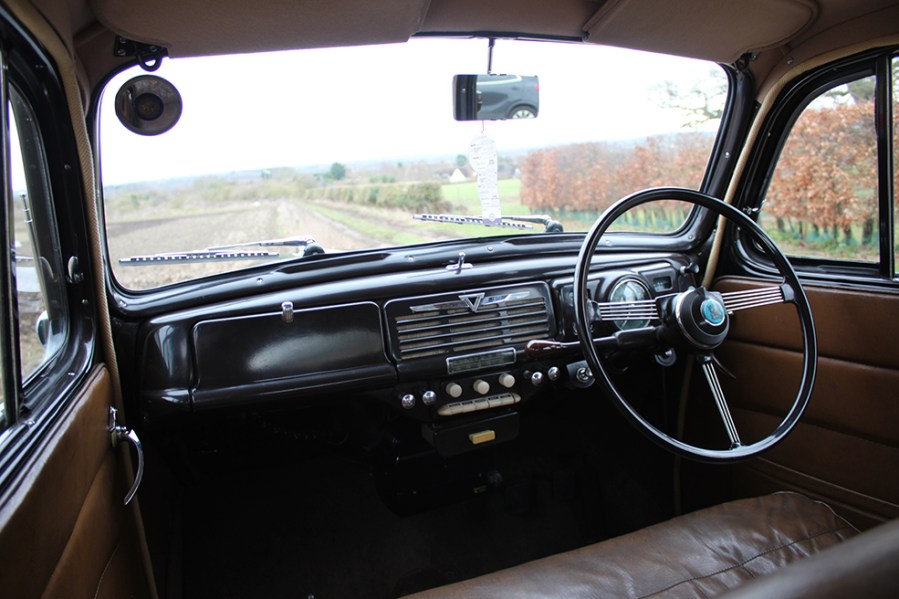The Vauxhall Wyvern was a post-war stop-gap that used late-1930s tech to great effect. We sample one of the last examples ever made
Words and images: Jack Grover With thanks to: RFH Classics
Like many car makers, Vauxhall had to produce a stop-gap model in the late 1940s to get civilian car production started after the war while new models were being prepared. For Vauxhall this was not too much of a struggle, since it had launched a trio of very advanced models in the late 1930s. These H-type Vauxhalls had been British pioneers, introducing features such as unitary construction, independent front suspension and overhead-valve engines.
Against strong opposition from its British managers, General Motors imposed a one-body policy on Vauxhall in the post-war era. Only two models would make up the L-type range, both sitting on the same platform that was essentially that of the pre-war Vauxhall 12. The platform, centre body, engine, drivetrain and running gear was re-used largely unchanged, but topped and tailed by new bonnet, front wings, grille and boot to cater to altered design trends. The four-cylinder model was named the Wyvern (for reasons never truly explained – Vauxhall’s mascot is a griffin) and was a direct replacement for the old Vauxhall 12.
The Velox, on the same platform and in the same body, boasted a six-cylinder engine and a higher level of interior trim. The L-types did introduce some advances of their own – they were the first British cars to have a dashboard designed to accept a radio (a £29 14s 9d optional extra), the first to have self-parking windscreen wipers, the first to have colour-coded warning lamps for charge and oil pressure, and the first to have no facility to use a starting handle. A well-received car that was praised for its economy, ride comfort and well-equipped interior, most L-type Wyverns built were exported, leaving home market cars a rarity.
Vauxhalls from the immediate post-war era are both rare and something of a niche interest – it was a period when the marque was still transitioning from a small maker of upmarket saloons and sports cars into the mainstream big hitter of later decades. Which makes it all the more amazing that this one has had the care and effort put into it that it has.
At time of writing this remarkable example is up for sale at RFH Classics in Bedforshire. One of the last L-type Wyverns built, this car has covered a little under 41,000 miles since 1951 across three owners and has survived in remarkably original condition. The first owner kept the car until 1984 and put on most of the miles recorded (all confirmed by a full and comprehensive set of records). The second owner made little use of the car and the most recent custodian took it over in 2006. He carried out a lot of work at a steady pace over the next 16 years that amounted to a heavy refurbishment but not a complete restoration, since much of the car’s interior, trim and drivetrain didn’t need it. The result is a car that combines the best of original and new.

The bodywork was the focus of the refurbishment, which resulted in the magnificently even and shiny black paint worn by the car now. There isn’t a trace of corrosion anywhere on the bodywork and the chassis has a good layer of paint and underseal that has yet to even get a decent covering of road dust. The austere black body with black wheels is set of nicely by the large amount of chrome on the exterior, including the chromed swages in the bonnet that were carried by all Vauxhalls from the 1920s to the mid-1950s. It’s all in excellent condition with no dullness, let alone any pitting. It’s also worth mentioning that the body carries a plethora of period stickers and badges, with a badge bar above the front bumper marking the Festival of Britain, the coronation of Elizabeth II and various motoring and travel club memberships, plus stickers from a variety of European countries on the rear windows.
The standard interior colour for most Wyverns, regardless of body colour, was grey cloth. But being from the last year of production this one has ‘bronze’ leather hide. The interior was largely untouched by the car’s refurbishment, which adds a lovely well-aged appearance and smell while still looking smart and complementing the refreshed body. The dark brown dashboard with its cream Bakelite switches is in fine condition. All the instruments and the two colour-coded warning lights (a much-vaunted feature of the E-type Vauxhalls) work, as does the original fitted-from-new radio that has been rebuilt to work with modern signals. The seats themselves have creases and crinkles that show they have been sat in, but no soft patches, rips or tears. The carpets are also entirely original and show some signs of wear in the high-impact areas but do not let the side down and maintain the car’s originality. Period add-ons to mention here include a 1950s fire extinguisher in the boot and an ‘Autoaid’ first aid kit in a tin under the passenger’s seat.
It’s the same story under the bonnet – a bit of a sea of black-painted metal, but it’s all in lovely condition and is in the sort of state you’d expect a low-mileage car to be. It’s not been over-restored to an unnaturally glossy state, just smart and tidy. The electrics are all new (with period-looking woven-cloth insulation on the wires) and there is even a modern reproduction of a 1940s-style Exide-branded battery. The carburettor is freshly rebuilt as well. Other touches include a paper tag on the radiator reminding us that it’s filled with ‘Bluecol’ anti-freeze and a spare set of spark plugs in holders on one inner wing.
With a rather frantic, but brief, bit of action from the starter, the Wyvern purrs into life easily. There’s a real sense of mechanical smoothness with this car, from the quiet way in which the engine runs to the restrained curtseying motion of the suspension over bumps. The column change clunk-clanks between ratios easily enough once you have the pattern sussed out, although at low speeds the lack of synchromesh on first gear is a challenge to be mastered.
A 1940s Vauxhall saloon is never going to be a totem of excitement, but it is very pleasurable to drive. The Wyvern was still quite an advanced car for its period and it shows in how refined and easy this one is to drive, despite its frumpy upright looks. It sits on a course well, without any frantic see-sawing at the wheel required, while the steering is numb and a bit heavy but reassuringly accurate. Performance is modest but the engine is quiet and pulls well, never feeling laboured.

Vauxhall Wyvern: our verdict
This car is a lovely object to spend time and interact with, which is a testament to the thought and care that has gone into its upkeep and refurbishment. There are very few E-type Vauxhalls left, and certainly none in as good condition as this one.
Mention really has to be made here of this car’s history file which is more like a library, consisting of multiple document cases that not only include registration documents, handbooks, invoices and MoTs as you’d expect, but much more besides. Included are the car’s original petrol ration coupons from the early 1950s, the original paper labels that were put around the dashboard switches at the dealer so the new owner would know what they did without having to look at the book, aftermarket guides, brochures for the E-type Vauxhall from multiple markets across Europe, records of the car’s appearances in historic TV series, and even a pair of Wyvern jigsaws.
It really isn’t just the case of buying a car – as good as it is – but a museum-quality exhibition.

















